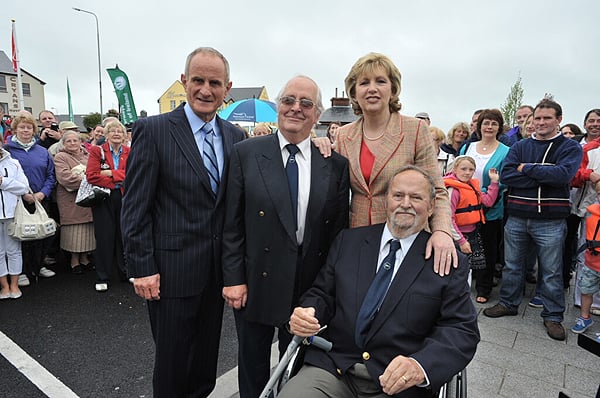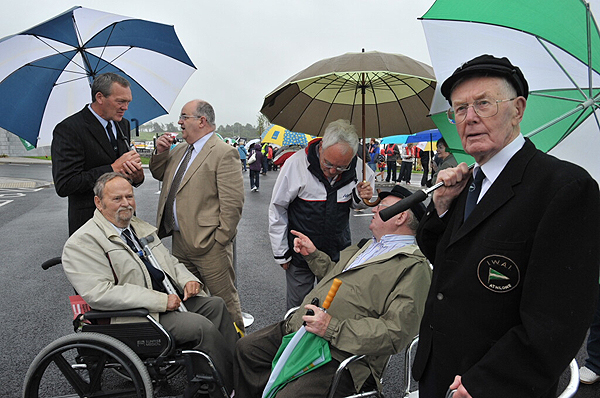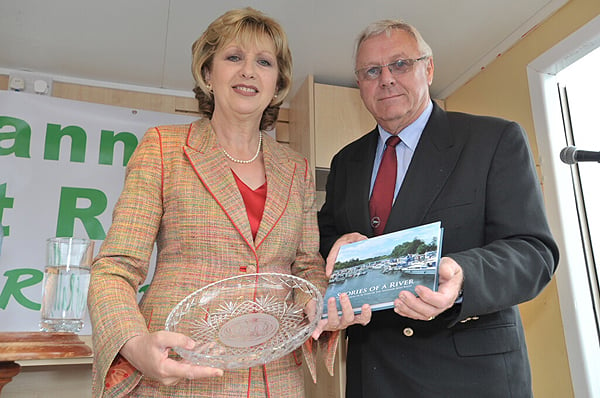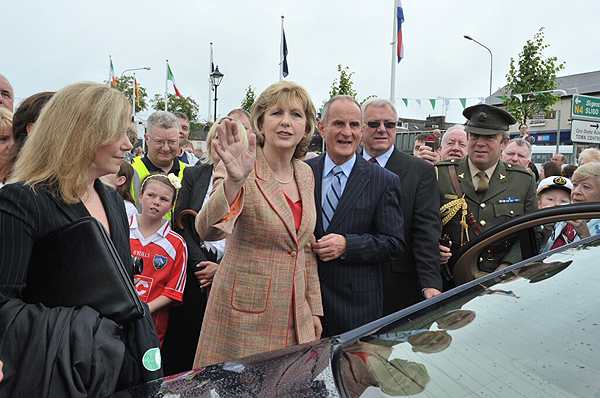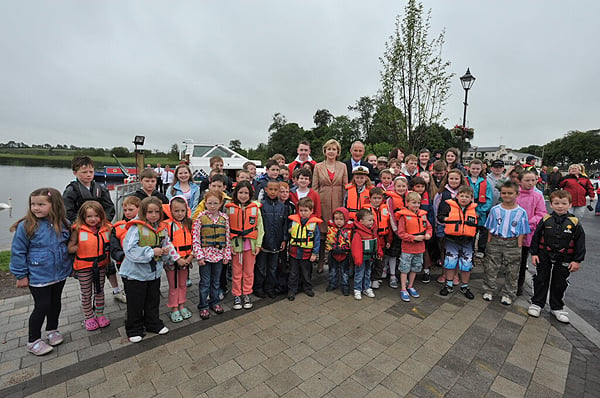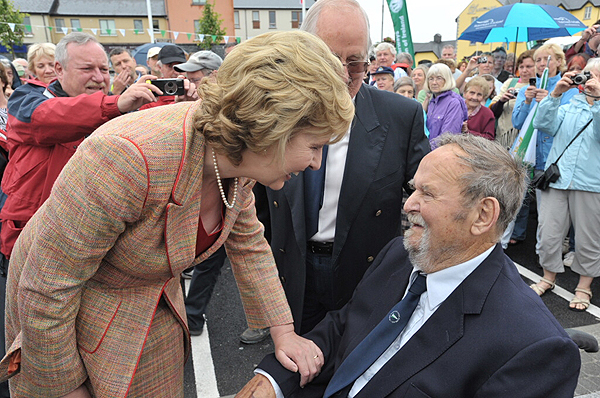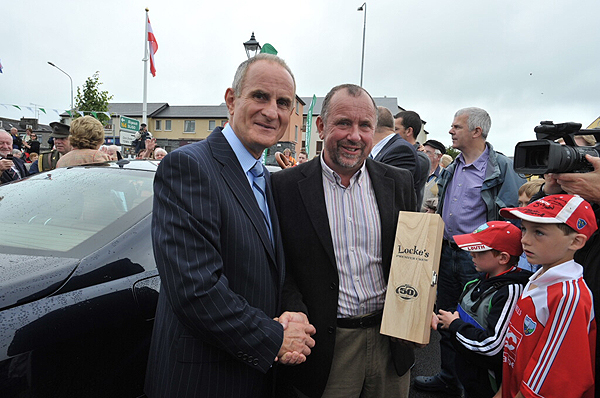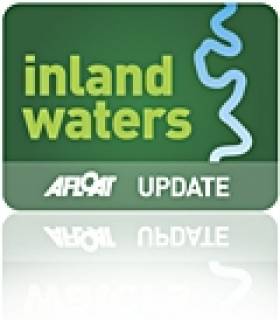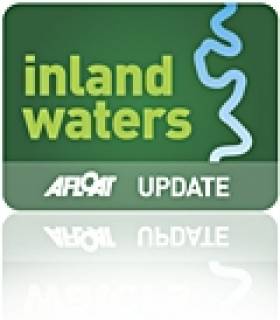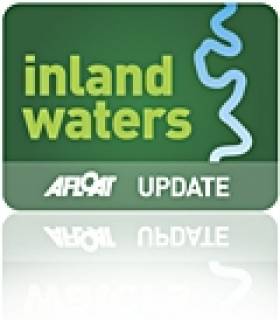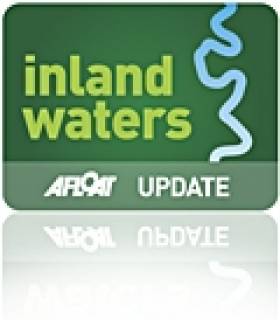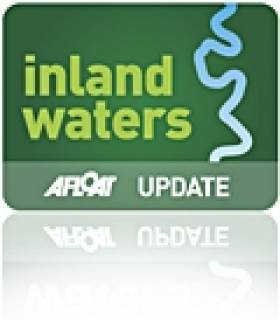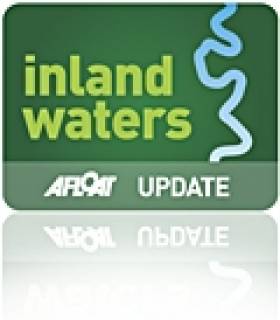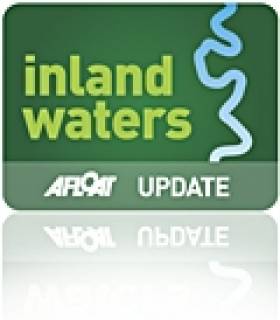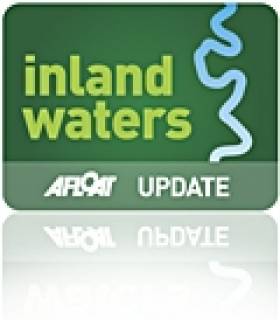Displaying items by tag: IWAI
#drogheda – The river Boyne at Drogheda welcomes 25 powerboats in the first of the town's Maritime Gathering events on Saturday, April 13th.
As reported by Afloat.ie in February, the Inland Waterways Association of Ireland, Powerboat Branch will be making their inaugural visit to Drogheda Port and Town.
The boats will gather at the mouth of the river at Mornington around noon and from there they will cruise into town in convoy in the company of the ports Pilot boat, the Lifeboat & the Coastguard, coming under the Viaduct at about 1230pm.
The beach at Mornington or Baltray will provide a perfect viewing point.
The boats will eventually land ashore at the Mall steps to be greeted by the Mayor, Paul Bell at 1pm. The Samba Band will be full swing on the Scotch Hall side to greet
the boats and the public are very welcome to come along to provide a warm and memorable reception for the visitors.
Future of Graving Docks in Limbo as Plot 8 is Transferred to NAMA
#INLAND WATERWAYS - The site of the former graving docks at Grand Canal Dock has been transferred to NAMA in a deal which frees the Dublin Docklands Development Authority (DDDA) from a €29 million plus bank guarantee.
Plot 8 at Sir John Rogerson's Quay is one of a suite of nine sites that have been transferred to the Government's 'bad bank' in a negotiated loan settlement that extricates the Docklands body from loan guarantees given by banks that financed the "disastrous" Dublin Glass Bottle site deal in 2006.
Sites handed over in the deal include the former 'U2 Tower' and the historic BJ Marine premises on the banks of the Liffey, as well as the aforementioned Dublin Glass Bottle site.
The Dublin branch of the Inland Waterways Association of Ireland (IWAI) had been hoping to embark on a restoration of the graving docks at Plot 8 to their former working order (a detailed history of the docks and restoration plans is available HERE).
This project had been given the blessing of the DDDA and Waterways Ireland, which owns the freehold lease on the site, with a view to its restoration helping to fund the Ulster Canal scheme.
However with the transfer of the DDDA's interest in the site to NAMA, the authority has now withdrawn permission for the IWAI to do any restoration work, leaving the future of the graving docks in limbo.
Largest Vessel Transits Samuel Beckett Swing-Bridge
She remained alongside this berth which is normally used by large commercial ships until the vessel sought a berth much closer to the city-centre. This led to a shift of berths in the evening when the 2003 built vessel headed upriver to the Dublin City Moorings facility at Custom House Quay, but this firstly required transiting through two bridges.
With a beam of 10.6m Fortunate Sun entered through the East-Link toll-lift bridge followed by the Samuel Beckett bridge, the Liffey's newest crossing point which opened in late 2009. The €60m bridge was commissioned by Dublin City Council and designed by the Spanish architect engineer Santiago Calatrava. To read more on the bridge click HERE.
Fortunate Sun is registered in the Caymen Islands and is capable of over 17 knots on a range of 5000 nautical miles. She has a steel hull and an aluminium superstructure and interiors also by Tim Heywood Design. In the early hours of tomorrow morning the vessel built by Oceanfast is to depart through the 5,700 tonnes bridge which was delivered by barge after a five-day voyage from Rotterdam.
There has been previous transits of the bridge notably the annual Dublin Rally organised by the the Inland Waterways Association of Ireland (IWAI). This year's Dublin Rally took place on 1 May when boats travelling on the Royal Canal descended via Croke Park and entered the Liffey at Spencer Dock. This required the Iarnrod Éireann bridge-lift and the water level in Spencer Dock to be lowered so to allow safe clearance under the Sheriff St. bridge.
From there the IWAI flotilla made the short passage downriver to re-enter another inland waterway system at the Grand Canal Dock, marking where the Liffey connects with the city's southern canal. The 2011 Dublin Rally was the first time since 1955 that boats could enter Dublin from the Shannon via the Royal Canal and the first time since 2004 that boats also joined from the Royal Canal.
- powerboats
- motorboats
- inland waterways
- Dublin Port
- Dublin
- Grand Canal
- IWAI
- Royal Canal
- DDDA
- Inland Waterways Association of Ireland
- Dublin City Council
- Spencer Dock
- River Liffey
- Ports and Shipping News
- EastLink Toll Bridge
- Dublin Port news
- Grand Canal Dock
- Dublin Docklands Development Authority
- M.Y. Fortunate Sun
- Tim Heywood Design
- Lifffey
- Dublin City Moorings
- Custom House Dock
- Powerboat news
- Motoryachts
- Sir John Rogerson Quay
- Inland Waterways news
- Dublin Rally
- Ianrod Eireann
- Oceanfast
- Scottish Western Isles
Sailors Plan Month Long Journey from Shannon to Liffey and Back
Nenagh resident and inland waterways enthusiast, Nick Theato, single-handed aboard 'Bo-Bo, a five metre Pedro trailer/sailer and Pat Kelly, Killadangan, with his son Andrew in 'Shu-Ra-Nu', a 6 metre Etap 20 trailer/sailer, plan to raise funds for Lifeboats Ireland by undertaking the IWAI Green & Silver Challenge in June, 2011. Their fundraising target is €5,000.00.
On the 25th June, 1946, Tom and Angela Rolt left Athlone aboard 'Le Coq', a 28ft.x8ft. converted ship's lifeboat on a voyage that would inspire contemporary and successive generations of inland waterways enthusiasts.
Tom Rolt wonderfully documented the voyage in his book 'Green & Silver', published in 1949, which has since become a classic. This work was instrumental in inspiring the small group who founded the Inland Waterways Association of Ireland in 1954, whose objective was to save the Shannon navigation from strangulation by low bridges. Indeed, the colour scheme of the IWAI's logo and burgee derive from the cover design of Rolt's book.
With the re-opening of the Royal Canal in October 2010, it is now possible to retrace Rolt's journey in full and complete the circular route formed by the Royal Canal, River Liffey, Grand Canal, River Shannon and Camlin River.
To celebrate this event, the IWAI has initiated the 'Green & Silver Challenge' in an effort to encourage people to make the circular journey. Nenagh resident, Nick Theato single-handed aboard 'Bo-Bo, a 16 foot Pedro trailer/sailer and Pat Kelly, Killadangan, with his son Andrew aboard 'Shu-Ra-Nu', a 20 foot Etap trailer/sailer, plan to raise funds for Lifeboats Ireland by travelling the full Green & Silver Route throughout June 2011.
Departing on June 1st, they will travel from Dromineer through Lough Derg and Lough Ree and enter the Royal Canal at Richmond Harbour. They plan to cross the Liffey in Dublin 17 days later, where they will take a welcome day off before commencing the return journey via the Grand Canal to Shannon Harbour. The journey will take approximately 28 days, will cover a minimum of 333 km. and navigate through 92 locks (some double), 91 of which are manual. Their fundraising target is €5,000
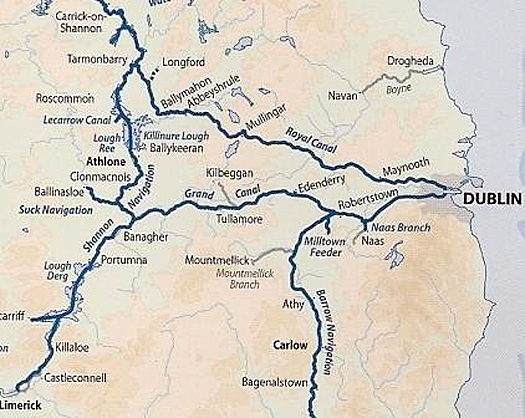
Nick Theato is Treasurer of the Lough Derg RNLI Fundraising Branch and Lough Derg Lifeboat Station at Dromineer.
Pat Kelly is Secretary of the Lough Derg RNLI Fundraising Branch.
Nick and Pat welcome all sponsorship, however modest. Contributions can be pledged online at http://www.mycharity.ie/event/green_silver_event/. Nick may be contacted on 086 1738014 ([email protected]). Pat is at 087 6908099 ([email protected]).
For further details / interviews / photos: Contact Pat Kelly at 087 6908099 ([email protected]). Support photography: Gerardine Wisdom 087 6522582 ([email protected]).
The IWAI has delivered
The Inland Waterways Association of Ireland is a strong and vibrant body, writes Paul Garland, in response to the article by our correspondent in the last issue of Afloat...
Having read with interest Brian Goggin's assessment of how he perceives "The Inland Waterways Association of Ireland is having a mid life crisis and shooting itself in the foot", I would like to thank the editor for this right of reply.I have no intention of dissecting the article line by line. I would rather explain our origins through to our future plans.
The Association was founded in 1954 to fight the threatened closure of the Shannon Navigation, by placing low fixed bridges at Athlone, Lanesborough and Roosky. Its first ten years were tumultuous, fighting the government to be as far sighted as our founding members. Not all the battles were won and even the bridges over the Shannon were a compromise as the local authority felt that 'yachts were owned by the privileged few' but probably the single most important achievement of the IWAI was preventing the erection of these low bridges.
The Sixties and Seventies saw off threats to both canals in Dublin. The Eighties and Nineties saw the association starting to receive help from the OPW in developing the inland waterways network. Prior to this, much of the laying of marks and dredging was carried out by local branches of the association.
Lobbying for improvements has always driven the association and right from its foundation it has found like-minded politicians and indeed ministers with some insight into the potential of the waterway network.The present Minister, Eamonn O'Cuiv, is a good friend to the association and its goals and shares our dream of taking a boat from Belfast to Limerick via the Ulster Canal.
It was in April 2000 that the IWAI delivered. None of the members realised what an important day that was. Most thought that establishing Waterways Ireland under the Good Friday Agreement was going to give them more byelaws and lead to a lot of confusion over the name, as the observant reader may have noticed even in your last issue this was the case.
What no-one clearly saw was that this was the dream of the association; a well-funded, well-staffed department whose only remit was to improve the waterways of the island of Ireland and hence the headline 'The IWAI has delivered'.
Of course, there were initial teething problems but I can assure you that Waterways Ireland and the IWAI have entered a period of mutual co-operation that our founders could not have envisaged. Where there are issues like the Grand Canal Dock and the Royal Canal opening, we are working closely to resolve them.
All through the period of growth for the waterways, complimentary organisations were being established, in many cases taking on roles that this association's volunteers had carried out. The Heritage Council, the EPA, Birdwatch Ireland, Duchas, Forest and Wildlife, An Taisce have all by and large helped.
So what future has this association when it has won the battle for the finest waterways in the world? Obviously there are still threats out there and lobbying to be done. Water abstraction from the Shannon for Dublin City Council has to be fought and, as in the past, a solution will be found that satisfies the majority, like we did 55 years ago.
As I see it, our future lobbying role may well be on behalf of our boaters in the EU. We have already entered this arena with Diesel Derogation, Boat Registration, E Borders, the Recreational Craft, and the Water Framework Directives.
It's no mystery that we are in constant contact with the ISA and have had a strong relationship since we jointly developed an Inland Waterways Training Scheme in 1997.
By 2002 we had formalised a joint Mutual Recognition Accord. The real growth of our association is to provide a service to anyone who wants to put a boat on any inland waterway on this island. At present can we provide members with over 200 activities, from boat rallies to training days. They can download Waterways charts, access our website iwai.ie for a wealth of information, read four quality magazines each year, access our online shop, and avail of discounts on goods and services. There's also a very active chat line. However, the real strength of the association is sitting on a boat, chatting with friends who just happen to be members as well.
I have great hopes for the future of the IWAI. In addition to our lobbying, heritage and other roles, few people realise that we are the biggest single entity boat club on the island with 4,500 members and attracting several hundred new members each year.
Our events grow year on year. We now have 20 branches. Yes, there people who – heaven forbid – have sports boats and possibly a few with gold medallions, but they are welcomed with open arms. Let more of them come aboard; if we get enough, we'll form a Sports Boat Branch.
Most of our barge-owning members are also in the HBA (Heritage Boat Association) and we fully support them sharing events. Again, we would like them to come aboard as a Branch. We are going to the membership looking for ways to make the association even better in a series of focus groups. But it will be our members who will shape the IWAI's future and certainly not a journalist looking backward.
This year will see us in Galway for the Volvo Ocean Race, Athy for the Ploughing Championships and Belfast for the Tall Ships, with a new corporate event trailer. Please come and have a cup of tea with us. Perhaps Brian G will even drop in for the interview that we have offered him!
Paul Garland is President of the Inland Waterways Association of Ireland
Dead Swans Found On Grand Canal
The Inland Waterways Association of Ireland (IWAI) has confirmed a number of reports of dead swans found along the Grand Canal in south Dublin.
IWAI representative Colin Becker said some of the dead birds were taken away for analysis, while a number of sick birds were taken for treatment by the DSPCA.
As of yesterday morning "another half dozen" deceased swans were discovered between Portobello Harbour and Suir Road Bridge.
Initial reports are pointing to a form of botulism or other bacterial infection. No source had yet been pin-pointed but "a number of dead and rotting sea-fish were found in the area", according to Becker.
He added that swans are known to be susceptibe to bacterial infections.
The IWAI ruled out the presence avian flu, and dismissed suggestions that dredging of the canal might have disturbed bacteria in the sediment, as the infected swans were found some distance from the current dredging site.
Shannon Sinkings Result of Poor Winter Preparation
Owners of boats moored on the River Shannon and its tributaries and the inland waterways are counting the costs of the recent icy conditions which have caused the sinking of a high number of vessels.
The Irish Times reports that the Inland Waterways Association of Ireland (IWAI) has advised all boatowners to check their boats after reports of sinkings across six counties.
Among the sunken vessels are a 35ft cruiser opposite the Landmark Hotel in Carrick-on-Shannon. The worst situation is reportedly in Shannon Harbour, with an unusually high number of boats sunk or partially submerged.
Sunken boats often require full refitting to replace damaged finishings and damaged electronics. But of greater concern is the potential environmental impact due to fuel or oil spills, or the leaking of antifreeze and other chemicals.
The IWAI has blamed poor 'winterisation' as a factor in the sharp increase in sinkings.
Winterisation involves the closing of sea cocks to prevent water entering the intake pipes and potentially bursting them when it freezes, or leaking when it thaws.
"Owners need to check on their craft regularly or have a local do it," said IWAI president Paul Garland. "The lessons learned this winter must be taken seriously. Heaters may not be enough; all sea cocks have to be shut."
Click HERE for Afloat.ie's advice on protecting your boat in the thaw.
New Powerboat Branch Launched by IWAI
To raise the profile of Irish powerboating at a time when power-boaters are the most likely target for regulation the Inland Waterways Association of Ireland (IWAI) has formed a new power-boating branch. It will be the twenty first branch of the association.
The move mirrors a similar adoption of powerboat interests by the Irish Sailing Association who appointed a powerboat officer to promote the interests of this sector of the sport.
The objects and ethos of this new IWAI branch is to promote the use of the inland waterways to the many people who use Powerboats, RIBs, PWCs and Sports boats from Trailers and Marinas anywhere on the island of Ireland and indeed further afield.
The first meeting will take place in Cox's of Dromod, Co Leitrim on Fri 21st. Jan at 7.30 PM, a committee will be elected, a calendar of events will be approved, but most importantly, says IWAI President Paul Garland "we need founding members, like minded people to help develop this new Branch Single Membership is Euro44 & family is Euro 55 per annum and all of the privileges of IWAI membership apply with quarterly magazines over 200 organised events, training, funding, but most importantly lobby power with four thousand members our voice has become known as the voice of the waterways and with increasing legislation we have found the voice of powerboat users is simply not being heard".
More from Paul Garland on 086 8217712
Naas Canal Festival Includes 'Best Lit' Boat Competition
Friday Oct 22nd
Arrival of boats in Naas harbour
Saturday Oct 23rd
12:00 – 18:00 IWAI Trailer
12:00 - 14:00 Registration in the Canal Stores
14:00 – RNLI Display and Safety Check
19:00 Coordinated switch on of Boat Lights
19:00 BBQ in the Canal Stores
19:00 - 22:00 Best Lit Boat Competition
Saturday & Sunday all day activities
Raffle for a Weekend for 4 people on a luxury Shannon Cruiser
Best Dressed Boat Competition
Children's activities – register on Sat at 12:00 in Canal Stores
Art/Craft Competition – for Children 12 and under – register on Sat at Canal Stores
Sunday Oct 24th
11:00 – 17:00 Canal Boat Festival – Boats and their history will be on display externally
11:00 – 17:00 Canal Boat 107B – Canal display available for viewing internally
10:00 Small Boat Rally up the Corbally Line 19:00 Entertainment in the Townhouse – Judging & Prize Giving
Monday Oct 25th
11:00 Walk & Talk with the Naas Historical Society
President McAleese Opens 50th Shannon Boat Rally (Pics here)
Over 500 boaters gathered to welcome the President and Dr McAleese. President of the Inland Waterways Association of Ireland. Inland Association president Paul Garland said “The McAleese family is no stranger to the River Shannon. Most of us have had their friendly wave as they pass by and I know that they share that special joy we all have by simply being on the river”
Scroll down for Images
On a typical wet Irish morning, President McAleese officially opened the Inland Waterways Association of Ireland 50th Shannon Boat Rally, Saturday 24th July in Carrick on Shannon.
In her address, the President recalled her first boating experience on Lough Ree – “Martin and I were only baby boaters at that time – as we met our first four foot wave, our son Justin – who had little faith in our boating skills – called on us to contact the coastguard!” Reflecting on the significance of the River Shannon to the towns, villages and communities along its route, the President said “from this silver garland – our river Shannon – you see Ireland from a different perspective”
Over 140 boats, barges and sailing cruisers crewed by over 500 people will spend the next two weeks holidaying on the River Shannon bringing much needed business to the many small towns and villages along the banks of the Shannon. The two largest towns on the river - Carrick on Shannon and Athlone along with Waterways Ireland – have invested significantly in the river’s navigation, harbours and facilities which makes boating a pleasure for the Shannon Rally. The Shannon Rally goes from strength to strength said Commodore of the 50th rally, Donal O’Siocháin, with more and more people choosing to holiday in Ireland on our rivers – year on year.
President McAleese concluded by thanking the IWAI volunteers – “the custodians of the river, the champions of the river – who cherish the river – they have taught us to be careful of the river – to keep it for the next generation.
Commodore Donal O’Siocháin presented President McAleese a specially commissioned Leitrim crystal plate engraved with the rally emblem and a copy of the newly launched book “Stories of a River” - commemorating 50 years of the Shannon Boat Rally. Vice Commodore Tom Meegan presented Dr McAleese with a bottle of single malt Irish whiskey – one of only 292 bottles matured at Kilbeggan’s Locke’s Distillery especially for the Shannon Rally.
The event was attended by Frank Dolan Cathaoirleach Leitrim County Council, County Manager Leitrim County Council - Jackie Maguire, and Waterways Ireland Chief Executive Waterways Ireland - John Martin.
The full text of IWAI President, Paul Garland's speech, and Rally Commodore Donal O'Siocháin's speech follow.
Opening Addresses of IWAI President, Paul Garland
President, Cathaoirleach, Commodore, Ladies and Gentlemen, we are deeply honoured here today by the President, Mary McAleese's attendance as we mark this moment the opening of the 50th Shannon Boat Rally.
The McAleese family are no strangers to the River Shannon. Most of us have had their friendly wave as they pass by and I know that they share that special joy we all have by simply being on the River. We thank them for their continuing support as members of our association.
I would like to thank Leitrim County Council and Lei trim Tourism for all their support and encouragement during my time as President of this association, and to take this opportunity to congratulate them on the recent improvements to Carrick, the county town. I think you will agree it has never looked better.
Since Brian Boru brought a fleet of 300 boats up to Lough Ree from his base in Kincora in 1010 we have had 1000 years of recorded boating on the Shannon. I do not wish to compare the Shannon Boat Rally to a Raid on the Vikings but if the hat fits it's easy enough to add the horns.
Over the intervening years the Shannon and the connected waterways have influenced the many aspects of Irish life, people have lived beside it pre history, it has gone from Battle Field of Vikings to the Motorway of the industrial revolution, early monastic settlements show the holistic attract ion. By the 1930's it was giving a fledgling state electricity. It was in the early 1950's that the Shannon and Canal system saw its biggest threat. Years of decline led the government of the day to propose a Bridge Order, which would repeal the Shannon Navigation Act and allow initially a fixed low level Bridge at Athlone with Tarmonbarry and Roosky to follow. A campaign followed with a series of letters headed "Strangling the Shannon". The great friend of waterways and founder member of this association, Harry Rice, wrote "If a fixed Bridge was built it would lie functioning like so many planks across a Bog drain ,barring the passage of anything much bigger then a Lifeboat. If that happens, the closing ceremony of the Shannon will be preformed to the applause of its suicidal sponsors and the great River will sneak humbly through an ungrateful town that it could have helped to make a thriving city, neglected and forlorn, leaving behind its great future."
I am proud to read the words of our first President and of the insight that was shown by the man. Many of our founders have passed on but the legacy they have left us is celebrated every time we venture forth on what is recognised as the finest River in Europe.
It was not an easy time for these men of vision. They had each put a pound on the table and declared the association formed, Now What? Foremost was the right of navigation and the cruise of the Dragon Sailing Boat "Firedrake" is well recorded as its crew Vincent Delaney and Rory O'Hanlon assisted by the Sean Me Bride insisted with varying degrees of success that the Bridges were opened for their passage. This followed by a mission statement "To encourage water transport, to collaborate with tourism to encourage pleasure boating, to encourage Cruising under Sail and Power, t o publish Guides and compile historical and data records".
The next step was to commission a report into the establishment of a hire boat industry in 1953. Blakes, the Norfolk broads operator, admitted that the weather data was not encouraging and were quoted as saying that the Shannon would need a giant umbrella to make the hire boat business viable. George O’Brien Kennedy was certainly a man ahead of his time - he got me boating in the early 1960s and he was so free with his help that when a man from Guinness called Derek Dann came to his door he gave him the benefit of all his experience. That, coupled with the foresight of Carrick on Shannon people, Leitrim County Council and Fáilte Ireland lead Carrick to the enviable position of one of Inland Boating's Capital.
The campaign continued with improvements by the OPW, the Shannon Erne link, this years opening of the Royal Canal and of course, the planned Ulster Canal that will open Lough Neagh to southern boaters. The largest victory of all for this association is probably the least recognised and that was the establishment of Waterways Ireland under the Good Friday agreement. A well funded dedicated body with the mandate of improving and maintaining our waterways on the island of Ireland. All over Europe governments are slashing waterway authorities budgets, we are not totally unscathed but even compared to our neighbours in England who have lost 162 Million of their funds we are well placed to continue building on the success of recent years. We can never get complacent. Water abstraction, water quality, the need for a single authority are just some of the many issues facing us. Remember that all of our achievements are those of volunteers but today is probably what keeps us all members getting out on the River with friends and family.
A Uachlarain, A Chathaoirlig, A dhaoine Uaisle, Friends
To begin I must thank President McAleese for coming to open our 50th. Shannon Boat Rally. It is delightful to see the interest she shows in our inland waterways.
This Association was born in conflict, and that same conflict led to the institution of the first Shannon Rally in 1961. There was apian to use tow bridges for all crossings of the Shannon. This would have stopped all navigation on the river. The first Shannon Boat Rally was a continuation of the campaign to keep the navigation open. In this it was successful but it was successful in more ways than one as the ralliers discovered that this campaigning was fun . And so the Shannon Rally took off.
From the very early days it was decided that the Rally should also include an educational element, and the competitions ensued. The principle behind these was to improve the boat handling skills and knowledge of our members. The competitions have been supremely successful at this, even more so in that the ralliers discovered they also were fun.
Unfortunately many of our early ralliers are no longer with us but I am delighted to see some from the first Rally here with us today. Life was different in the early days. For starters the boats were so much smaller.
It was not unusual to see twelve boats or more in a lock together. Nowadays four is the maximum. Most ralliers camped out at night as they had no facilities for sleeping in the boats. There were many more sailing boats in the early days, indeed one participant in this Rally when entered in the second Rally sailed a dinghy from Athlone to Carrick and back to Athlone in one week, capsizing the boat for every bridge and power line. They were giants of men in those early days! There were also many more sailing and canal boats than we have seen in late years. I am delighted to note that the canal boats are making a welcome return to this historic Rally. It is a pity in ways that we have so few open boats entered in our modern Rallies. I suppose we are all too used to the good life.
The early Rallies had large numbers of boats attending, the second Rally for example had 150 boats. There was the campaigning element here of course, but there was also the fact that Esso gave free petrol to all entrants. I am not sure that all boats would have passed the safety parts of our current boat inspections!
The Shannon Rally goes from strength to strength. We have........boats entered in this Rally and I am looking forward to a great week of fun, competitions, music and companionship. I must finish up by thanking President McAleese for honouring us with her presence today. We are truly grateful. Thank you.
50th Rally Itinerary
The 50th rally begins on Friday 23 July and runs until Sunday 1st August. Boats will travel from all locations to arrive in Lanesborough by Friday evening 23rd for an informal start of the activities.
Friday 23rd July, Lanesborough Get together
Saturday 24th July, Carrick- on-Shannon - Opening of the Rally by President McAleese.
Sunday 25th July Cruise to Portrunny - Boating competitions en rout. Ecumenical service, Commodore’s wine and cheese reception
Monday 26th July Fleet rests at Portrunny - Competitions, dinghy sailing, zorbing, animal farm, table quiz
Tuesday 27th July Cruise to Lough Ree Yacht Club - Boating competitions en route BBQ, fancy dress for children and adults
Wednesday 28th July Fleet rests in LRYC - Competitions, commando competitions, dingy sailing, music, talent competitions for children and adults
Thursday 29th July Cruise to Lakeside Marina - Water sports, dingy sailing, RNLI Auction
Friday 30th July Fleet rests in Lakeside Marina - Land sports, prize giving, dingy sailing, 60’s Rock around the Dock
Saturday 31st July Cruise to Athlone - Informal night
Sunday 1st August Fleet rests in Athlone - Award Dinne, Sheraton Hotel, presentation of Premier and other professional trophies award.
